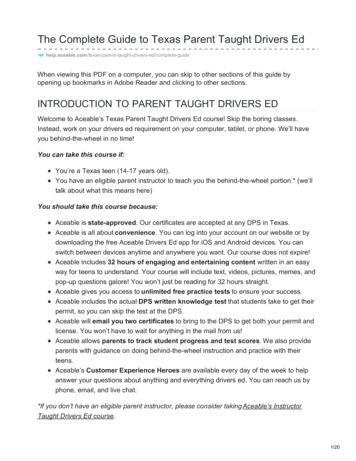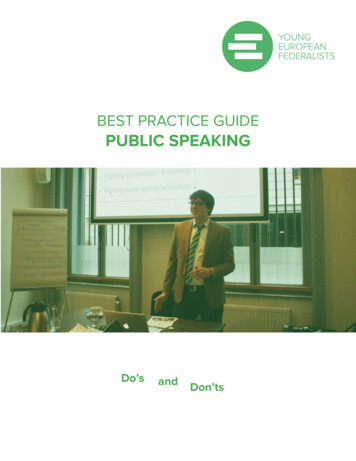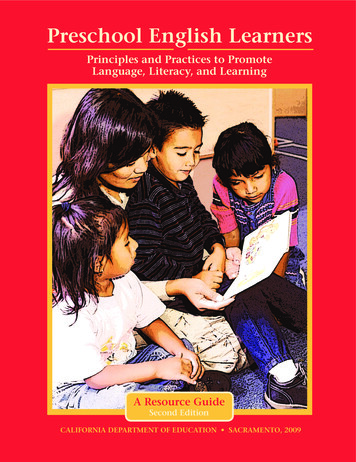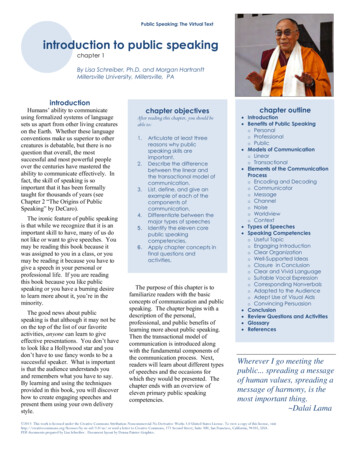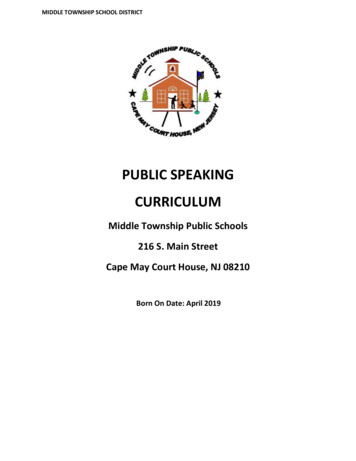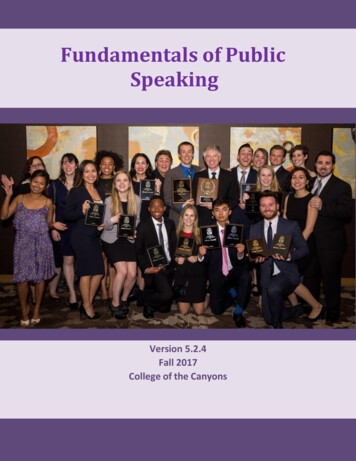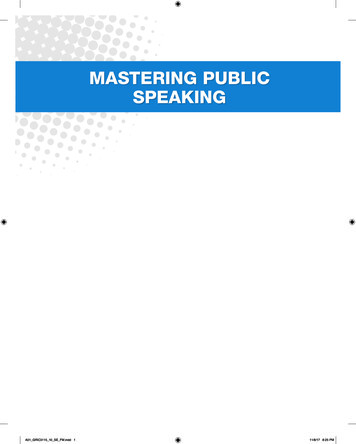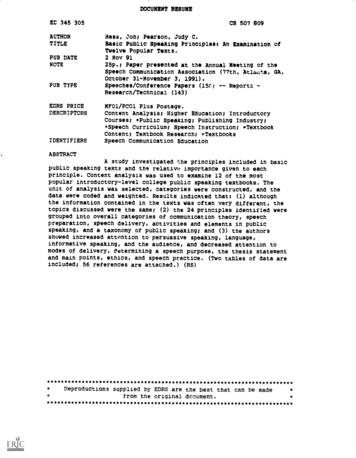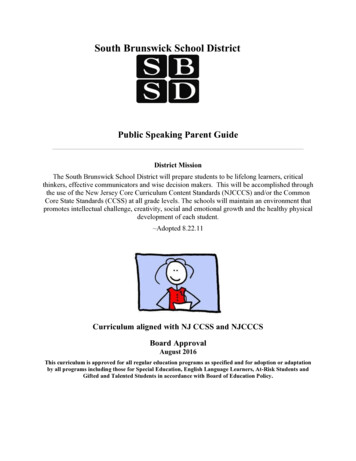
Transcription
Public Speaking Parent GuideDistrict MissionThe South Brunswick School District will prepare students to be lifelong learners, criticalthinkers, effective communicators and wise decision makers. This will be accomplished throughthe use of the New Jersey Core Curriculum Content Standards (NJCCCS) and/or the CommonCore State Standards (CCSS) at all grade levels. The schools will maintain an environment thatpromotes intellectual challenge, creativity, social and emotional growth and the healthy physicaldevelopment of each student. Adopted 8.22.11Curriculum aligned with NJ CCSS and NJCCCSBoard ApprovalAugust 2016This curriculum is approved for all regular education programs as specified and for adoption or adaptationby all programs including those for Special Education, English Language Learners, At-Risk Students andGifted and Talented Students in accordance with Board of Education Policy.
AcknowledgmentsWe are appreciative of the leadership provided by our curriculum supervisors and specialists and theknowledge, skills, work and effort of the teachers who served on our curriculum writing teams. In manycases, our units are “home-grown.” While aligning with NJ State and Common Core State Standards,they are designed with the needs of the South Brunswick student population in mind.ArticulationCurriculum Development Teams comprised of teachers at every grade level cluster along withrepresentative special education as applicable meet together throughout the year as needed. In a timeperiod of major revision, the teams will meet with greater frequency.“There are always three speeches, for every one you actually gave.The one you practiced, the one you gave, and the one you wish you gave.”–Dale Carnegie
TABLE OF CONTENTSPublic Speaking Preamble Philosophy Instructional Practices 21st Century Connections Program Delivery Assessment Resources Core Content Curriculum Standards Curriculum and Overview of Units of Studyo Public Speakingo Honors Public Speaking Appendix
PREAMBLEPublic speaking is the number one fear in America. Death is, somehow, a distant second.As the famous Jerry Seinfeld punch line goes, “This means to the average person, if you have to be at afuneral, you’d rather be in the casket than doing the eulogy.” From sweaty palms and bundles of nerves toa cracking voice and butterflies in your stomach, speaking in public can be downright terrifying.So, even though (a) college offers a course in speech communication, chances are you might be temptedto avoid it like the plague. However, taking a public speaking class has some surprising benefits.Here are five reasons everyone should take a public speaking course:1. You’re likely to need the experience it offers.Although the majors that are most in demand vary from time to time, the skills that employersseek in their new applicants are nearly identical year after year. A 2013 survey by the NationalAssociation of College and Employers found that the ability to communicate effectively is thequality employers most want to see in new recruits.Regardless of the career you have planned, you’re bound to find yourself in situations whereyou’ll need to give an oral presentation. Whether you’re an accountant, an architect, a surgeon ora scuba instructor — communication skills are essential for your career development.Furthermore, outside of the workplace, the likelihood that you’ll end up speaking in public is alsoquite significant, whether that be at church, a school board meeting or a community event. Plus, ifyou are asked to say a few words at a funeral or are encouraged to give a toast at your bestfriend’s wedding, thanks to your speech class, you’ll be more than ready. You’ll be confident andexperienced.2. It will help (with) your other classes.The skills you’ll learn in a public speaking course will help you succeed in your other courses.Regardless of your major, many college classes will require some sort of presentation. Why notgo ahead and discover how to make your presentations interesting, informative, and entertaining?Additionally, a public speaking class will give you experience in applying your abilities as aresearcher and critical thinker, which will surely aid you in other classes.3. It will help you be a better listener.Listening may be a lost art, but a public speaking course actually teaches you to become a betterlistener. In the class you’ll hear several different kinds of speeches about a wide variety of topicsfrom people who may be very different from you, which can be a beautiful thing. And while theinstruction you’ll receive about being an active listener will help you do things like take betternotes in your classes, the real benefits of being a better listener are relational.Effective communication can help you develop more meaningful relationships with the peopleyou care about and that, of course, starts with listening. After all, listening is the communication
activity we do the most, but it’s the skill we’re taught the least.4. It encourages you to voice your ideas.It’s no secret that people throughout history have used the power of public speaking to make adifference. A public speaking course, if you approach it with the right perspective, is a greatchance to do the same thing.You’ll hardly ever have a better opportunity to speak to a captive audience about what reallymatters to you. You’ll get a chance to influence your peers. You won’t change the world withevery speech, but you can easily impact someone in some small way. Then, you can continue tospeak up and make a difference long after the semester’s over.5. It teaches you to “face fear.”A public speaking course (will) build your confidence. You’ll learn to stand before a group ofpeople, make a lot of eye contact, and engage them with conviction. While the nervousness thatcomes with speaking in front of a crowd won’t entirely disappear, the course will teach you howto deal with your fears and turn your weakness into strength.By the end of the (course), you can emerge from the class having overcome America’s biggest fear,which is no small feat.After you’ve done that, think of what else you’ll be capable of doing.This article comes from The USA TODAY College Contributor network, January 2014.Written by Jeremiah Massengale is an assistant professor of communication arts at the University of theCumberlands in Williamsburg, Kentucky. He also works as a freelance writer and editor with interests inpopular culture, religion and technology.
21ST CENTURY CONNECTIONSSALT (skills, awareness, literacy and traits) are developed and nurtured in the language arts program.Skills: Critical Thinking & Problem SolvingCreative Thinking & InnovationCommunication & CollaborationCore Ethical ValuesAwareness: Global Cross Cultural CareerLiteracy (beyond ELA) Links to all other areas of Core Content Technology Literacy Media LiteracyTraits or Habits of Mind: Initiative Productivity Responsibility Self-direction Self-expression Perseverance Empathy Taking responsible risks
PROGRAM DELIVERYOur Public Speaking standards-based environment fosters understanding of big ideas and thinking aboutessential questions.There are multiple and varied forms of assessment—formative and summative. Teacher made tests, quizzes and projects Teacher observations/ conferences Student response activities Performance tasks Rubrics/checklists Published speeches Unit assessments (pre-post) Course assessments (pre-post) Student Reflections Benchmark Assessments- PARCC Grades 9, 10, 11 Grade 12 Research Task- rubric scored (Health Education)-public presentationThe resources for Public Speaking are rich and varied. Generally speaking, the following materials areused to anchor the program: Text resources, Audio resources, Visual resources, Media resources,recording devices, filming devices, and other technologiesSPEAKING AND LISTENING STANDARDSThe following standards offer a focus for instruction each year to help ensure that students gain adequatemastery of a range of skills and applications.The grade level standards correspond to the College and Career Readiness (CCR) anchor standards belowby number. The CCR and grade-specific standards are necessary complements—the former providingbroad standards, the latter providing additional specificity—that together define the skills andunderstandings that all students must demonstrate.Comprehension and Collaboration Prepare for and participate effectively in a range of conversations and collaborations with diversepartners, building on others’ ideas and expressing their own clearly and persuasively. Integrate and evaluate information presented in diverse media and formats, including visually,quantitatively, and orally. Evaluate a speaker’s point of view, reasoning, and use of evidence and rhetoric.Presentation of Knowledge and Ideas Present information, findings, and supporting evidence such that listeners can follow the line ofreasoning and the organization, development, and style are appropriate to task, purpose, andaudience. Make strategic use of digital media and visual displays of data to express information andenhance understanding of presentations. Adapt speech to a variety of contexts and communicative tasks, demonstrating command offormal English when indicated or appropriate.LANGUAGE STANDARDS
The following standards for grades offer a focus for instruction each year to help ensure that students gainadequate mastery of a range of skills and applications.The above standards define what students should understand and be able to do by the end of each grade.They correspond to the College and Career Readiness (CCR) anchor standards below by number. TheCCR and grade-specific standards are necessary complements—the former providing broad standards, thelatter providing additional specificity—that together define the skills and understandings that all studentsmust demonstrate.Conventions of Standard English K-12 Demonstrate command of the conventions of standard English grammar and usage when writingor speaking. Demonstrate command of the conventions of standard English capitalization, punctuation, andspelling when writing.Knowledge of Language K-12 Apply knowledge of language to understand how language functions in different contexts, tomake effective choices for meaning or style, and to comprehend more fully when reading orlistening.Vocabulary Acquisition and Use K-12 Determine or clarify the meaning of unknown and multiple-meaning words and phrases by usingcontext clues, analyzing meaningful word parts, and consulting general and specialized referencematerials, as appropriate. Demonstrate understanding of word relationships and nuances in word meanings. Acquire and use accurately a range of general academic and domain-specific words and phrasessufficient for reading, writing, speaking, and listening at the college and career readiness level;demonstrate independence in gathering vocabulary knowledge when encountering an unknownterm important to comprehension or expression.LITERACY ACROSS THE CONTENTThere is also a set of explicit literacy standards for grades 6-12 in History/Social Studies, Science andTechnical Subjects. The CCR anchor standards in reading and writing, and grade level standards inliteracy work in tandem to define college and career readiness expectations—the former providing broadstandards, the latter providing additional specificity.
PUBLIC SPEAKING CURRICULUM
FUNDAMENTALS OF PUBLIC SPEAKING: AN OVERVIEWContent Area: English, Public SpeakingCourse Title: Fundamentals of Public SpeakingGrade Level: 11-12Course Description or Content Overview: This college-level course provides an introduction to thetheory and practice of public address. Through making in-class presentations, critiquing speeches, andresearching for assignments, students will acquire an understanding of what it takes to present an effectiveand interesting speech. Critical thinking, listening skills, and personal creativity will be emphasized. Theclass provides numerous practical opportunities to give various types of presentations includingpersuasive, informative, demonstration, and improvised speeches. While this course is primarily aperformance course, students will be expected to research and write speeches as well as to participateactively as a listener and critic. Students will gain experience that will benefit them in high school,postsecondary education, and the business world. This course does not fulfill the English graduationrequirement.Course Rationale: Being able to give speeches and make presentations is an important skill in college,business, and social situations. The skill is developed and confidence is gained through experience instructuring, writing and delivering many different speeches. Through studying various forms of publicspeaking as well as writing and giving a variety of speeches, students will gain the necessary skills to givemany types of presentations.Primary Interdisciplinary Connections:Cross Curricular: English/Language Arts through speaking, writing, listening and media literacy —Social Studies through research and analysis; historical context —Performance through elocution and presentationTechnology: —Use presentation aids such as slide shows and PowerPoint —Use web sites for research and supporting information —Use digital video cameras for presentation project workCharacter Education (Core Values):South Brunswick High School’s core values of honesty, respect, responsibility, kindness, and service areaddressed and stressed throughout the course. Student have the opportunity to: —Recognize the importance of ethics in communication and speaking ethically —Use sources in ethical ways
—Consider diversity in an audience when focusing a speech—Analyze both sides of a controversial subject—Speak with integrityDemonstrate respect while listening and critiquingCareer: Develop the communication skills needed in business including the ability to make a presentation,work as part of a team, communicate clearly, and effectively sell a product.21st Century Connections:S Skills; A Awareness; L Literacy; T TraitsS Critical Thinking & Problem Solving Creativity & Innovation Communication &Collaboration Core Ethical ValuesA ⃞ Global Cross Cultural CareerL Content ⃞ Financial ⃞ Civic ⃞ Health Information Technology MediaT Initiative Productivity Accountability Responsibility Self Direction Leadership Humor Resilience Perseverance Empathy Responding withwonderment and awe Take responsible risks Other: RespectStandards:New Jersey Core Curriculum Content Standards (NJCCCS)Standard 1.3 (Visual and Performing Arts, Performance): All students will synthesize those skills,media, methods, and technologies appropriate to creating, performing, and/or presenting works of art indance, music, theatre, and visual art.Standard 8.1 (Technology, Educational Technology): All students will use digital tools to access,manage, evaluate, and synthesize information in order to solve problems individually and collaborativelyand to create and communicate knowledge.Standard 9.1 (21st-Century Life and Careers, 21st-Century Life & Career Skills): All students willdemonstrate the creative, critical thinking, collaboration, and problem-solving skills needed to functionsuccessfully as both global citizens and workers in diverse ethnic and organizational cultures.Standard 9.3 (21st-Century Life and Careers, Career Awareness, Exploration & Preparation): Allstudents will apply knowledge about and engage in the process of career awareness, exploration, andpreparation in order to navigate the globally competitive work environment of the information age.Common Core State Standards Initiative (CCSSI)Standards for English Language Arts 6-12, WritingStandards for English Language Arts 6-12, Speaking and ListeningStandards for English Language Arts 6-12, LanguageEnduring Understandings: Communication is an exchange of information that involves both verbal and nonverbalinformation. Communication includes both speaking and listening.
Speaking opportunities have four parts that affect how a speech should be delivered: the purpose,the audience, the speaker, and the message.Effective public speaking balances ethics, emotion, and logic.To be most effective, speeches must have structure and organization and, in some cases,appropriate visual materials.Confidence in speaking can be gained through relaxation, preparation, and practice.Successful public speakers understand the elements of the three major speeches and how toproperly deliver them.Public speaking skills are used frequently in real-world situations.Essential Questions: What does it mean to communicate? How can nonverbal communication change a speaker’s message? How can effective public speaking be recognized and described? What elements must be considered before writing and delivering a speech? What are the elements of an effective speech? How does an audience affect a speech? How does one deliver a speech effectively and with confidence? How does a speaker effectively use supporting materials in a speech? What ethical responsibilities does a speaker have? What are the ethical responsibilities of the listener? What are the similarities and differences among the three major speeches? How are public speaking skills used in life situations?Knowledge and Skills:Knowledge: Students will know Students will be introduced to many different types of public speaking. Students will know how to organize a speech through outlining. Students will know how to conduct research for a speech and use supporting materials tostrengthen their speeches. Students will learn types of visuals to use in speeches and the best ways to incorporate them. Students will be able to critique the speeches of peers and give constructive criticism. Students will demonstrate positive listening skills and appropriate audience behavior. Students will be able to adapt speeches for different audiences. Students will be able to evaluate speeches for both content and delivery. Students will demonstrate correct posture and appropriate nonverbal communication. Students will be able to use strategies to increase confidence.Skills: Students will be able to Prepare different types of speeches Research for speeches Outline speeches Evaluate the effectiveness of speeches Effectively use research and visual aids as support Appropriately vary voice in volume, tone, speed and pitch Demonstrate confident posture and appropriate gesturesTerminology:
After-dinner speechAnalogiesAnecdotesAppealArticulationAudience analysisBandwagon fallacyBody of speechCadenceCausal fallacyCause-and-effect organizationCentral ideaCeremonial speechesChronological organizationCitation of sourcesCommencement addressesCommunication, models ofConclusionConnotationConsensusCredibility of speakerCredible evidenceCuesDeclamationDeductive aborationElocutionEmpathic listeningEthicsEulogyExtemporaneous speakingFallaciesFaulty reasoningFeedbackFigure of speechForensic speakingHierarchy of needsHyperboleHypothetical illustrationsIllustrationsImmediacyImpromptu speakingInductive reasoningInference InflectionIntroduction speechKeynote addressLiteral analogiesMain ideaMotivated sequenceNeeds of listenersNomination speechesNonverbal communicationNonverbal cuesObjectiveOccasionOral citationOrganization of ersonal experience speechPersuasionPlagiaphrasingPlagiarismPositive motivationPresentation AidsProblem-and-solution organizationPropositionProximityPurpose of speechRedundancy, RepetitionReflective thinkingRephrasingRhetoricSequence, motivatedSituational audience analysisSourcesStatisticsStyle of speechSupporting materialSymbolsTarget audienceTestimonyThesisTopicVerbal transitionsVisual aidsWord pictureWritten vs. oral language
Formative Assessments:Ongoing, throughout unit of study: Do Now activities Analysis of famous speeches Nonverbal communication exercises Relaxation techniques Outlining Class discussions Peer critiques Audience analysis Audience behavior exercises / positive listening activities Improvisational exercises Self-evaluation papersSpecific interim assessments: Unit Tests Projects/Speeches of various types including:o Introductiono Personal Experience (e.g. Eulogy, Award)o How-To / Demonstrationo Informativeo Persuasiveo Film Project / Commercialo Impromptuo Workplace ScenariosSummative Assessments:Final ExamCourse Resources:Technologies: Computer with word processing, PowerPoint or other slideshow/presentation tool software, andInternet search capabilities LCD Projector Digital video cameras DVDs Texts and videos of famous speechesText: Beebe, Steven A., and Beebe, Susan J. Public Speaking, An Audience-Centered Approach, EighthEdition. Allyn & Bacon / Pearson Higher Ed: 2012.ISBN-13: 978-0-205-78462-2ISBN-10: 0-205-78462-3Pacing Chart (Suggested Scope & Sequence - in alignment w/assessments)Timeframe Unit Description
Quarter 1Unit 1 - Speaking & ListeningChapter 1: Speaking with ConfidenceChapter 2: Speaking Freely and EthicallyChapter 3: Listening to SpeechesUnit 2 - Analysis & Research*Chapter 4: Analyzing Your AudienceChapter 6: Gathering and Using Supporting MaterialQuarter 2*Unit 3 - The Speechwriting ProcessChapter 5: Developing Your SpeechChapter 13: Speaking to InformChapter 7: Organizing Your SpeechChapter 8: Introducing and Concluding Your SpeechQuarter 3Unit 4 - Delivery & PresentationChapter 9: Outlining and Revising Your SpeechChapter 10: Using Words Well: Speaker Language and StyleChapter 11: Delivering Your SpeechChapter 12: Using Presentation AidsUnit 5 - The Persuasive Speech*Chapter 14: Understanding Principles of Persuasive SpeakingChapter 15: Using Persuasive StrategiesQuarter 4*Unit 6 - Speaking for LifeChapter 16: Speaking for Special Occasions and PurposesFinal Exam*NOTE: Unit 2 may cross over into Quarter 2, and Unit 5 is expected to cross over into Quarter 4.DEPARTMENT AGREEMENTS ON MINIMUM COURSE PROFICIENCIESIn order to receive credit for this course, students must exhibit proficiency in the topics described above.Grading / Assessments:Periodic evaluations will take place during each marking period. During the first marking period, theinstructor will explain his/her grading procedures to the class. Students will earn a grade for each markingperiod as well as a grade for the final exam.Minimum Proficiency:In order to pass Fundamentals of Public Speaking for the year with a minimum grade of “D,” a studentmust: have a grade of 65% or greater when the four (4) marking periods and the final exam areaveraged together.Students may have the opportunity to earn three (3) college credits from Middlesex County College. Inorder to earn college credit, a student must:
be enrolled in the High School Scholars program, andearn a grade of 70% or better.The following grading structure will be utilized: Unit Tests - 20% Projects / Speeches (graded with rubrics) - 50% Class work / Do Nows / Participation - 20% Homework / Self-Evaluations - 10%
HONORS PUBLIC SPEAKING: AN OVERVIEWContent Area: English, Public SpeakingCourse Title: Honors Public SpeakingGrade Level: 11-12Course Description or Content Overview: This course is designed to introduce students to the theoryand practice of public address with an emphasis on preparation and delivery. Through giving variouspresentations, performing research, and critiquing successful and well-known speeches, students willacquire an understanding of what it takes to construct an effective speech as well as the skills necessaryfor impactful and dynamic speech delivery and performance. Critical thinking, listening skills, andpersonal creativity will be emphasized. The class will provide numerous opportunities for students topresent on a range of topics for a range of audiences and purposes. While this course is primarily aperformance course, students will be expected to research and write original speeches of their own as wellas to participate actively as a listener and critic. Through all of these things, students will gain experiencein both the technical and artistic aspects of public speaking.*This course fulfills the Fine and Performing Arts graduation requirement but does not fulfill the Englishgraduation requirement.Course Rationale: Being able to give speeches and make presentations is an important skill in college,business, and social situations. The skill is developed and confidence is gained through experience instructuring, writing and delivering many different speeches. Through studying various forms of publicspeaking as well as writing and giving a variety of speeches, students will gain the necessary skills to givemany types of presentations.Primary Interdisciplinary Connections:Cross Curricular: English/Language Arts through speaking, writing, listening and media literacy —Social Studies through research and analysis; historical context —Performance through elocution and presentationTechnology: —Use presentation aids such as slideshows and PowerPoint —Use web sites for research and supporting information —Use digital video cameras for presentation project workCharacter Education (Core Values):South Brunswick High School’s core values of honesty, respect, responsibility, kindness, and service areaddressed and stressed throughout the course. Student have the opportunity to: —Recognize the importance of ethics in communication and speaking ethically
—Use sources in ethical ways—Consider diversity in an audience when focusing a speech—Analyze both sides of a controversial subject—Speak with integrityDemonstrate respect while listening and critiquingCareer: Develop the communication skills needed in business including the ability to make a presentation,work as part of a team, communicate clearly, and effectively sell a product.21st Century Connections:S Skills; A Awareness; L Literacy; T TraitsS Critical Thinking & Problem Solving Creativity & Innovation Communication &Collaboration Core Ethical ValuesA ⃞ Global Cross Cultural CareerL Content ⃞ Financial ⃞ Civic ⃞ Health Information Technology MediaT Initiative Productivity Accountability Responsibility Self Direction Leadership Humor Resilience Perseverance Empathy Responding withwonderment and awe Take responsible risks Other: RespectStandards:New Jersey Core Curriculum Content Standards (NJCCCS)Standard 1.3 (Visual and Performing Arts, Performance): All students will synthesize those skills,media, methods, and technologies appropriate to creating, performing, and/or presenting works of art indance, music, theatre, and visual art.Standard 8.1 (Technology, Educational Technology): All students will use digital tools to access,manage, evaluate, and synthesize information in order to solve problems individually and collaborativelyand to create and communicate knowledge.Standard 9.1 (21st-Century Life and Careers, 21st-Century Life & Career Skills): All students willdemonstrate the creative, critical thinking, collaboration, and problem-solving skills needed to functionsuccessfully as both global citizens and workers in diverse ethnic and organizational cultures.Standard 9.3 (21st-Century Life and Careers, Career Awareness, Exploration & Preparation): Allstudents will apply knowledge about and engage in the process of career awareness, exploration, andpreparation in order to navigate the globally competitive work environment of the information age.Common Core State Standards Initiative (CCSSI)Standards for English Language Arts 6-12, WritingStandards for English Language Arts 6-12, Speaking and ListeningStandards for English Language Arts 6-12, LanguageEnduring Understandings: Communication is an exchange of information that involves both verbal and nonverbalinformation. Communication includes both speaking and listening.
Speaking opportunities have four parts that affect how a speech should be delivered: the purpose,the audience, the speaker, and the message.Effective public speaking balances ethics, emotion, and logic.To be most effective, speeches must have structure and organization and, in some cases,appropriate visual materials.Confidence in speaking can be gained through relaxation, preparation, and practice.Successful public speakers understand the elements of the three major speeches and how toproperly deliver them.Public speaking skills are used frequently in real-world situations.Essential Questions: What does it mean to communicate? How can nonverbal communication change a speaker’s message? How can effective public speaking be recognized and described? What elements must be considered before writing and delivering a speech? What are the elements of an effective speech? How does an audience affect a speech? How does one deliver a speech effectively and with confidence? How does a speaker effectively use supporting materials in a speech? What ethical responsibilities does a speaker have? What are the ethical responsibilities of the listener? What are the similarities and differences among the three major speeches? How are public speaking skills used in life situations?Knowledge and Skills:Knowledge: Students will know Students will be introduced to many different types of public speaking. Students will know how to organize a speech through outlining. Students will know how to conduct research for a speech and use supporting materials tostrengthen their speeches. Students will learn types of visuals to use in speeches and the best ways to incorporate them. Students will be able to critique the speeches of peers and give constructive criticism. Students will demonstrate positive lis
Public Speaking Parent Guide District Mission The South Brunswick School District will prepare students to be lifelong learners, critical thinkers, effective communicators and wise decision makers. This will be accomplished through the use of the New Jersey Cor
